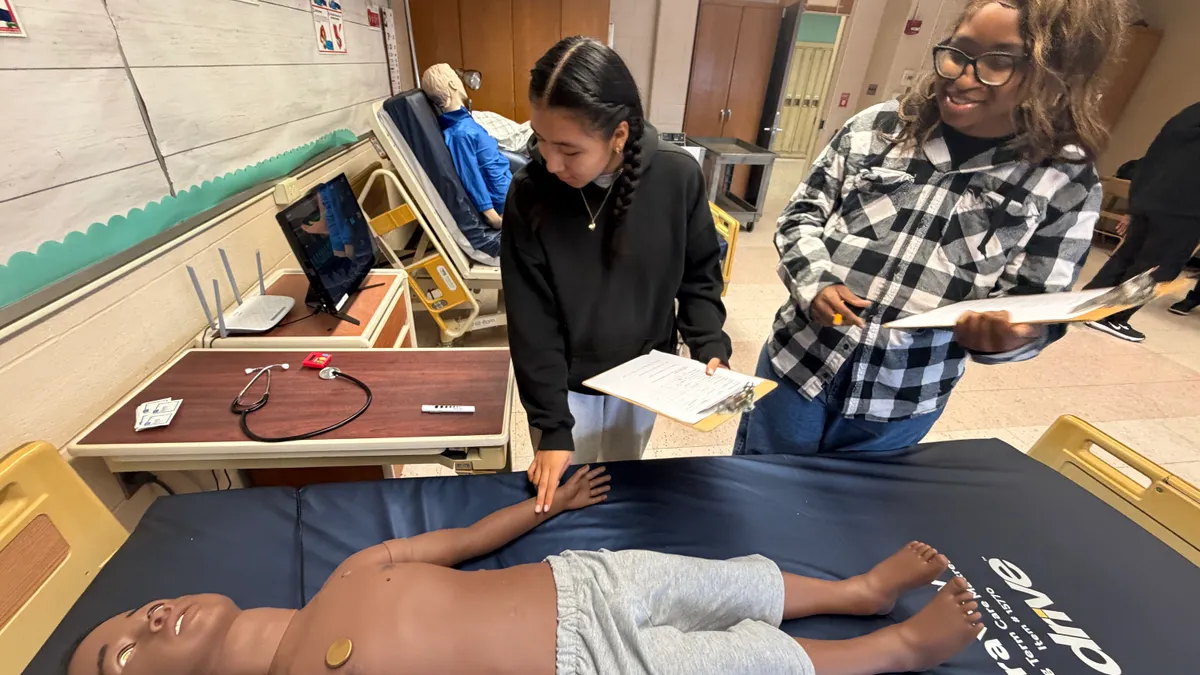How will potential cuts in federal funding and changes in civil rights enforcement impact English learners?
A new report from the Children’s Equity Project at Arizona State University raises concerns about proposed cuts to formula grants for Title III funding aimed at language skills for new immigrants and English learners, changes to Individuals with Disabilities Education Act funding for those with disabilities, and rescinded guidance on how to enforce civil rights laws that protect English learners.
The report, titled “Protecting Federal Funding to Support English Learners,” notes that English learners make up 11% of total school enrollment in the U.S., and it says that federal “investments have never been sufficient, but are a critical resource in nearly every district in the United States.”
While the Senate’s current budget proposal would keep Title III funding at current levels, both the Trump administration and the House have proposed eliminating it, the report points out, “conflicting with years of research on what schools need to improve opportunities and outcomes for these — and for all — students. This report shows the breadth of what’s at stake if these programs are reduced or eliminated.”
The federal government’s funding and role in tracking and enforcing civil right laws for English learners is key to providing equal access to education, said Shantel Meek, executive director of The Children’s Equity Project and a professor of practice at Arizona State University.
“This has been codified in civil rights laws, Supreme Court precedents and associated laws and regulations over the course of the last several decades. But funding and enforcing policies are critical pieces of this,” said Meek, one of the report’s co-authors.
Regarding civil rights enforcement, the federal government has rescinded the decade-old guidance meant to protect students on the basis of national origin, which Meek notes “alarmed some folks in the field, as an indication that they might not be enforcing that part.”
The mass layoffs within the U.S. Department of Education’s Office for Civil Rights and closing of regional offices are another cause for concern, she said, noting that those offices “were already understaffed to go through all the complaints the office received. Now, they’re even more poorly equipped to manage the complaints coming in.”
On the budgetary front, Meek expressed concerns about the proposed “zeroing out” of Title III and programs aimed at migrant students, including the Migrant and Seasonal Head Start program, the Migrant Education Program, the High School Equivalency Program and the College Assistance Migrant Program.
“There’s a real worry that some of that funding is in jeopardy,” she said, adding that there’s never been adequate funding.
“Title III is small compared to the need,” Meek said. “But removing even that inadequate number of dollars will have an outsized impact on this group of kids.”
But it will have little impact on the federal budget deficit, she said. While more than 90% of English learners receive Title III funding, the program only comprises 0.1% of the budget, meaning that it’s “not a place where we’re saving any meaningful amount,” she added.
The report also highlights the federal role under IDEA for English learners who have disabilities. Meek said the budget proposal from President Donald Trump would not significantly reduce funding but would “reshuffle things around” by consolidating preschool and K-12 special education funding, as well as combining line items for research, training and technical assistance, sending that directly to states.
“It’s unclear what that will mean for preschool special education,” she said of the former, while adding that the latter could mean “decreases in training opportunities specialized content folks need to have to understand disability and language at the same time — and research shows that’s how best to support kids with complex needs.”
All of this means school leaders “are in a really tough place,” Meek said, noting that the report contains testimonials from survey respondents about what they use Title III and other funding for, what would happen if it’s withdrawn, and what was about to happen before the administration agreed in late July to disburse monies that previously had been allocated.
On the funding front, the Children’s Equity Project researchers ultimately recommend:
- That Title III should receive about $1.7 billion in funding for the upcoming year, or about $300 per student.
- That IDEA be fully funded.
- That funding be preserved both for programs aimed at “the unique needs of migrant and migratory children” and “research and implementation support for districts and schools to better serve ELs, including those with disabilities.”
“Making up for those dollars is going to be challenging and something I’m not sure [states and districts] are going to be able to contend with, if those dollars are, in fact, cut,” Meek said. “There will be no easy answers.”
The report also advocates that the Office for Civil Rights be adequately staffed and provide “appropriate guidance and support” to ensure civil rights anti-discrimination measures are enforced, that policymakers protect and reinforce language access for students and their families, and that state, district and school policies and practices match current research underscoring the wisdom of integrated learning, dual language education, and evidence-based instruction and practices.
If that doesn’t happen, Meek cites an earlier report from the Children’s Equity Project, released in March and titled “Safeguarding the Civil Rights of Children & Families,” which discussed what states could do to shore up civil rights enforcement, especially pertaining to children.
“If in some world or universe the federal government stops enforcing some of these things, or enforces them incompletely or inadequately, states might be able to enforce or codify some of these rights,” she said, adding that some states already have passed such legislation.



















